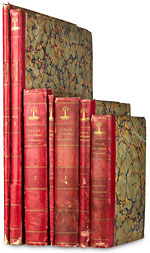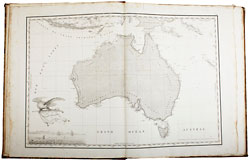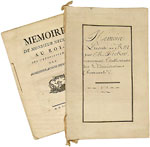Maps and Memoirs
Dastardly Deeds on the Farthest Shores
Péron & Freycinet, Voyage de Découvertes aux terres Australe… Lyon & Turnbull of Edinburgh on January 13, £37,600 ($61,665)
Distinguished by gilt lighthouse stamps on their period bindings, many lots in this sale came from the library of the Northern Lighthouse Board, the body that still manages Scottish lighthouses, buoys, and beacons. Voyages to the Pacific and Australia figured prominently, but this particular work is a reminder that, added to the considerable perils of sailing and charting unknown waters, conflicting colonial ambitions and underhanded tricks could also be a problem on those farthest shores.
This complete set of the seven text and plate or chart volumes issued from 1807-16 concerns a French expedition to the coasts of Australia which surveyed Van Diemen’s Land (Tasmania) in 1802, and, after a long stay in Sydney, spent six months surveying the entire southern coast of Australia. The commander, Nicholas Baudin, died at Mauritius during the voyage home and the expedition’s hydrographer and cartographer, Louis-Claude de Saulces de Freycinet took command.
The expedition’s naturalist, François Péron, began work on a general narrative, but he too died, and the work was completed by Freycinet, who also produced the ‘Navigation et géographie’ section. Much more uncommon than the general or ‘Partie historique’ section, it includes the first detailed and complete map of the Australian continent—reproduced here.
That famous map, however—indeed the whole work—benefited greatly from access to the impounded papers of an almost exactly contemporary British expedition, commanded by Matthew Flinders. This 1801-03 expedition completed the first circumnavigation of the continent—even meeting with Baudin at what is now Encounter Bay—but Flinders was imprisoned on Mauritius by the island’s French governor whilst on his way back to England to secure a replacement for his unseaworthy ship, Investigator.
Flinders was held on spurious charges of spying, and despite numerous protests, even a direct order from Napoleon, was kept there for over six years, his papers impounded. The French thus got into print first, and it was not until 1814 that Flinders’ own Voyage to Terra Australis finally began to be published in two text volumes and an atlas folio of engraved charts, coastal profiles, etc. A copy of that work made £16,450 in the Edinburgh sale.
High Finance Mémoire dealt a Low Blow
Jacques Necker, Mémoire présenté au Roi … concernant l’établissement des Administrations Provinciales, Bloomsbury Auctions of London on January 28, £9,760 ($16,005)
Necker’s Mémoire, at first circulated secretly amongst high-ranking officials at the court of Louis XVI, is a document that some later came to see as one of the seeds of the French Revolution. In 1778, France’s finance minister had discussed with his king the future development of the country’s government, suggesting reform of the unjust existing tax-gathering system. Necker believed that administration by local assemblies would lead to a fair system, and the king allowed him a pilot scheme at Bourges.
Aware that his proposals would meet strong opposition in some quarters, especially among those with a vested interest in seeing the continuance of the old ‘tax-farming’ system, Necker restricted circulation of manuscript copies of his Mémoire. But in 1781, the year in which he published his well-known report on France’s finances, the Compte rendu …, his enemies printed a copy of the Mémoire that had fallen into their hands. As they hoped, it weakened his position and helped force his resignation. Necker’s downfall may be seen as a serious blow to reform, but he was returned to office in 1788, on the very eve of revolution.
This very rare example of a Mémoire manuscript, a fair copy signed by Necker, was offered in company with a copy of the 1781 printed version, stitched as issued. The principal differences in the content, unsurprisingly, relate to the omission in the printed version of Necker’s remarks on the opposition he expected to face.








 Ian McKay’s weekly column in Antiques Trade Gazette has been running for more than 30 years.
Ian McKay’s weekly column in Antiques Trade Gazette has been running for more than 30 years.

